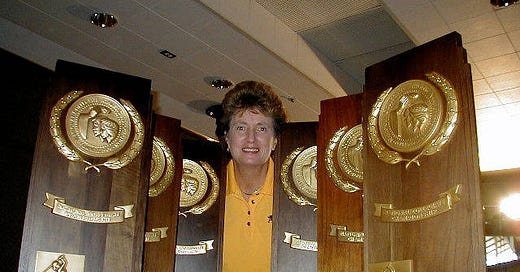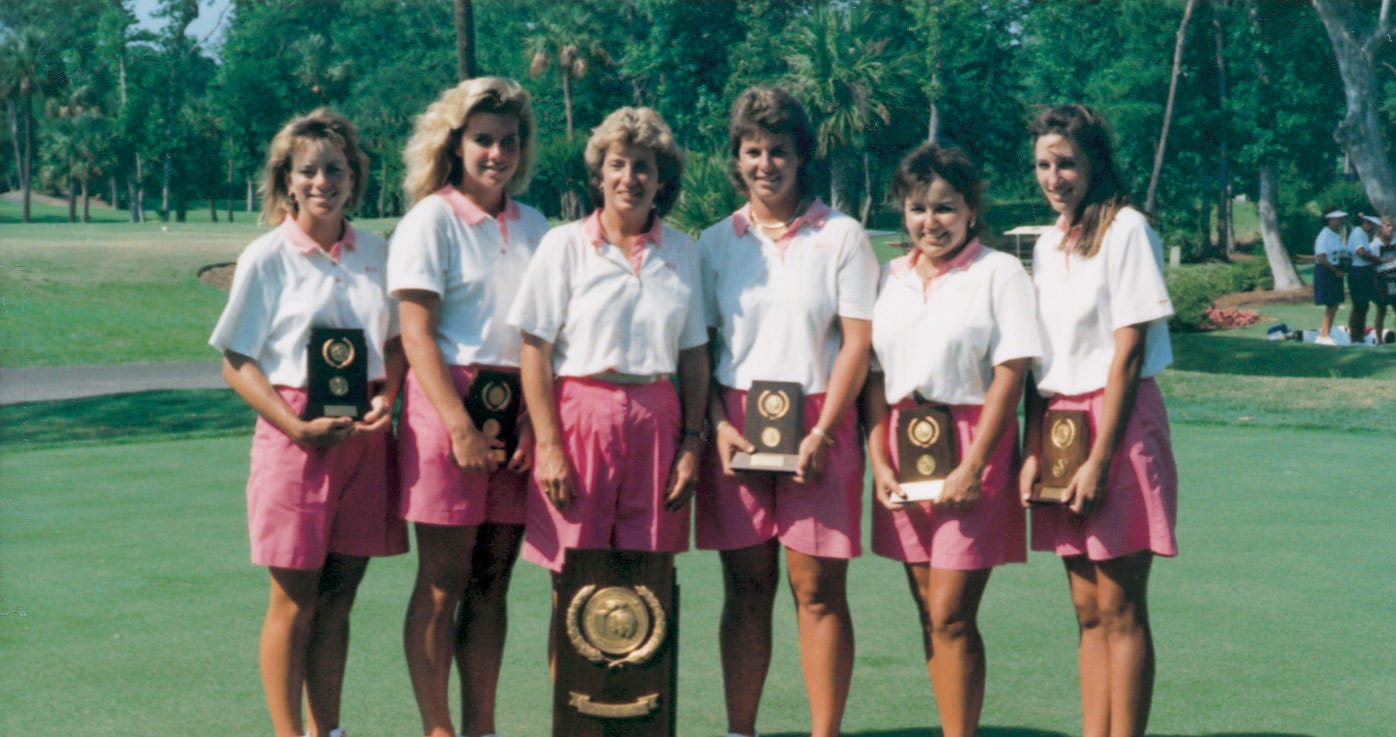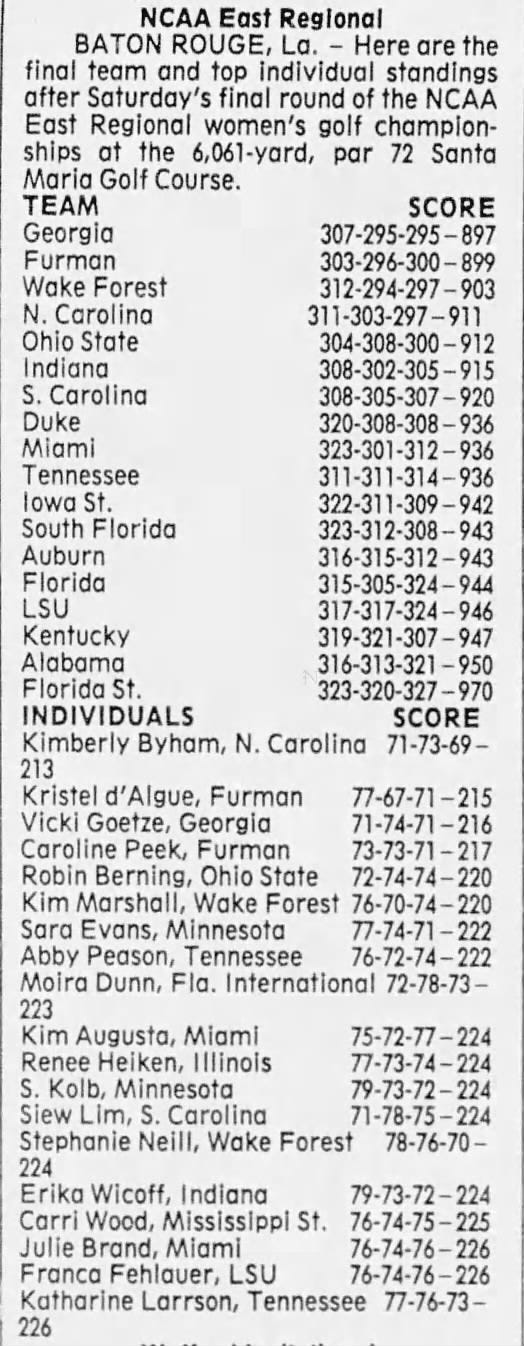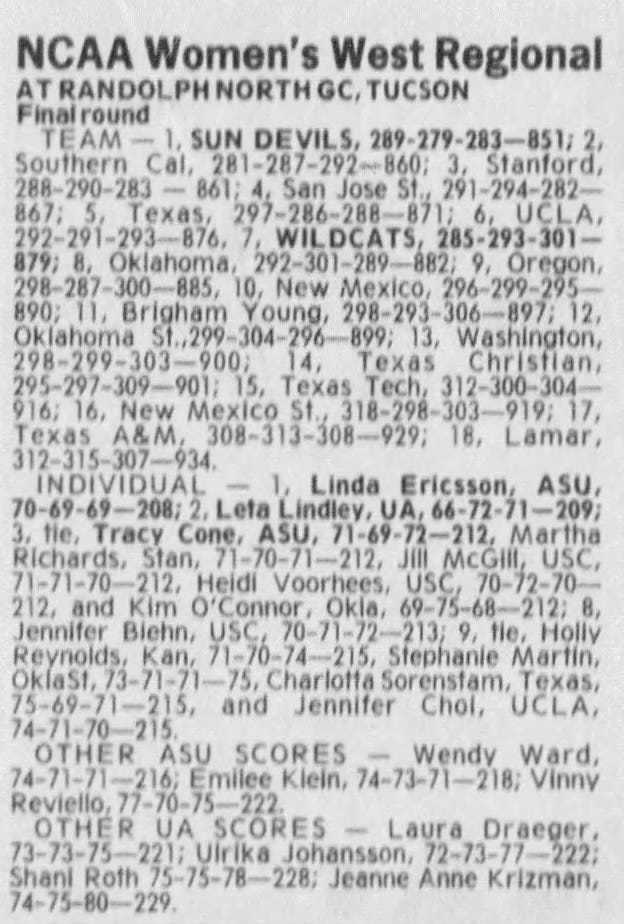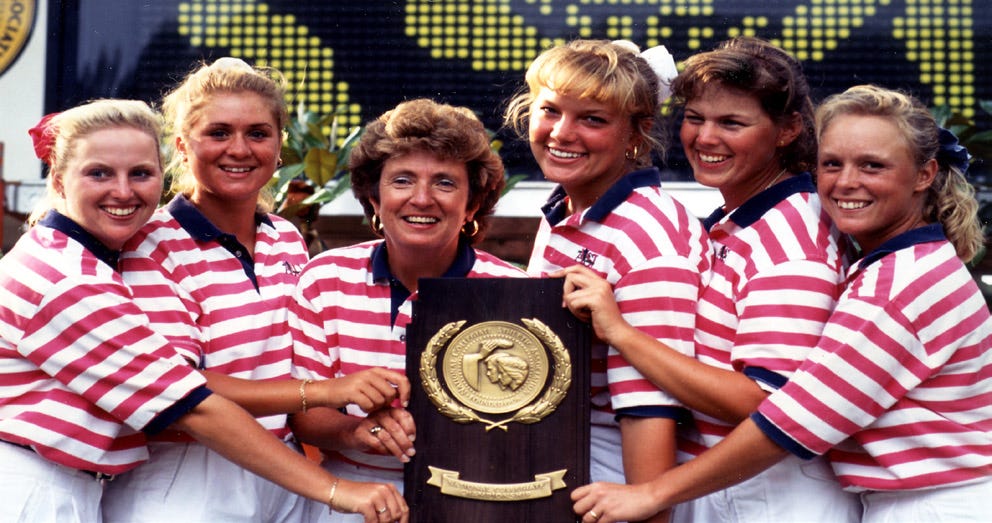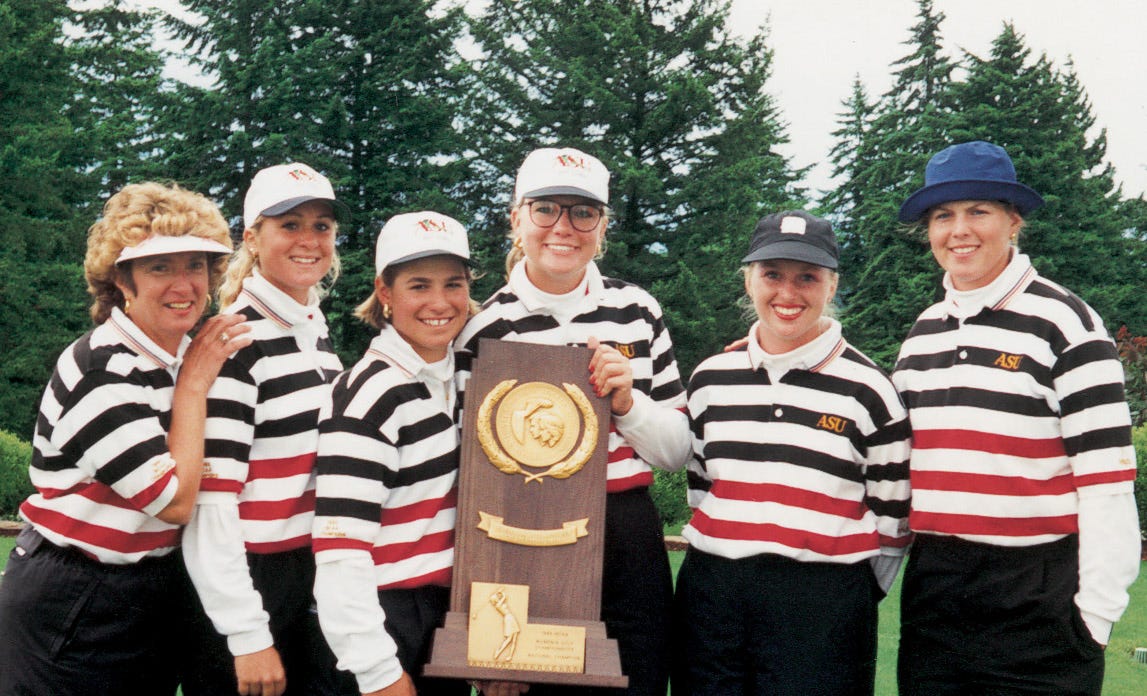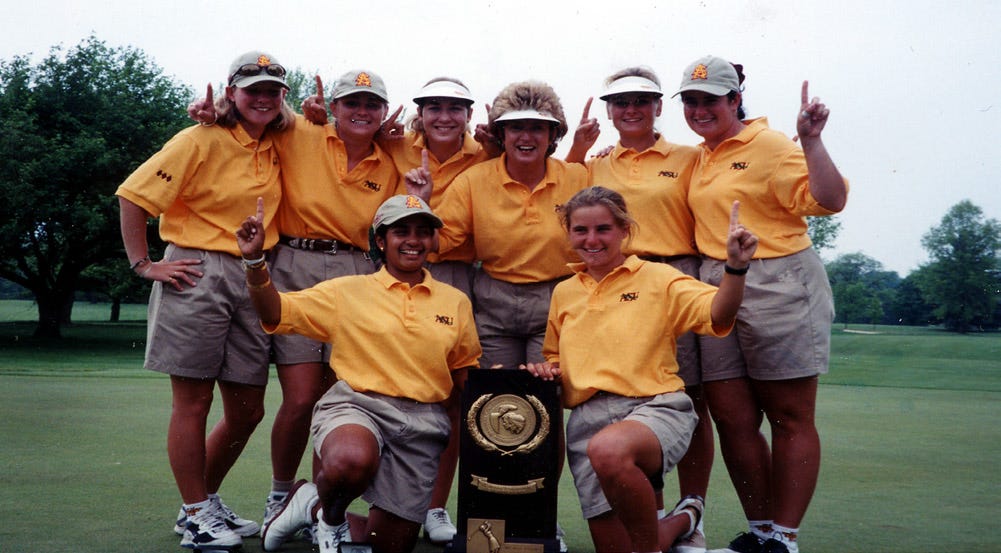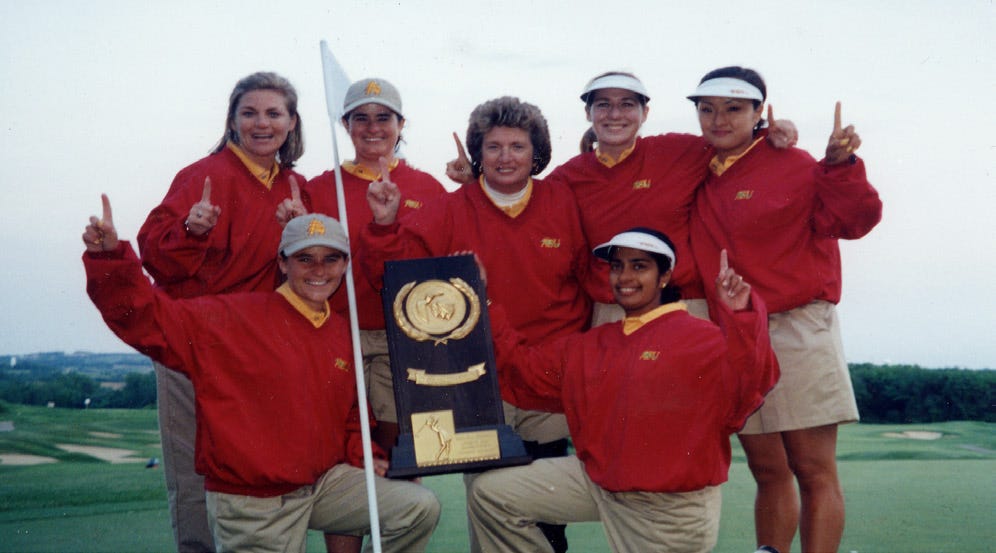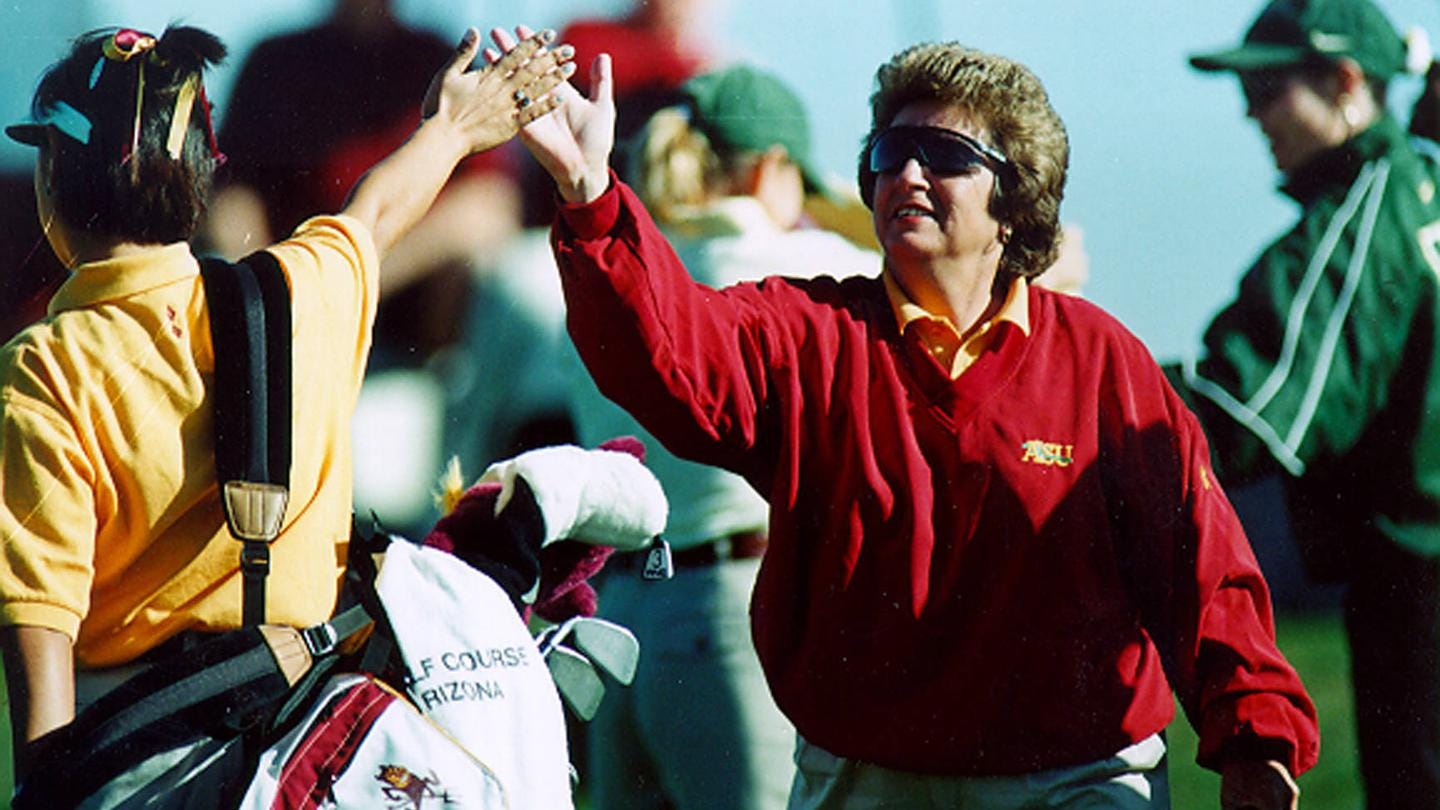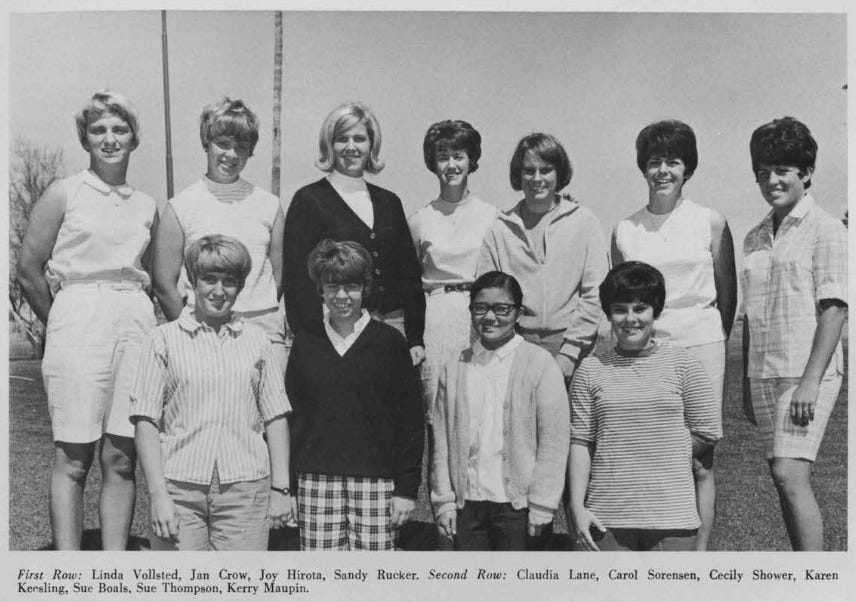This is part of a series on the Women’s Collegiate Championships
The 1990s was a decade of Sun Devil dominance in women’s college golf. Arizona State didn’t win everything, but it sure seemed like it as Coach Linda Vollstedt lead her teams to six NCAA team championships and three individual titles. If those numbers weren’t impressive enough, the 1995 championship capped off a historic undefeated season in which ASU won its third consecutive team title. Another defining change during this era of college golf was the addition of Regional tournaments that were (and still are) used as a qualifier for teams and individuals seeking their chance at an NCAA title.
*NOTE: underlined text provides a link to references or sites with more information
THE 1990 TITLE
The decade started on a high note for the Arizona State Sun Devil women’s golf program, winning their first team title in the NCAA era. Their last team championship win had come 15 years prior when it was the AIAW running the sport, but Coach Vollstedt’s teams had had a number of close calls throughout the 1980s, including two runner-up finishes in 1984 and 1988.
ASU seniors Missy Farr (future hall of fame head coach whose ASU teams won the 2017 NCAA championship) and Amy Fruhwirth lead the 1989-90 squad to six team tournament victories during the season, never finishing lower than third. Freshman phenom and 1989 US Women’s Amateur finalist, Brandie Burton - who earned Player of the Year honors - was sensational, winning six times1 including the Pac-10 championship. Unfortunately, the team fell just short of three-peating as Pac-10 champs. That disappointment apparently fueled the Sun Devils as they played their way to a 16 stroke victory at the NCAA championship. Burton (2008) and Fruhwirth (2005) were both inducted into the ASU Athletic Hall of Fame.
Something interesting to note for the 1990 NCAA golf championships is that this is the first (and as of 2023 only) time that the men’s and women’s programs from the same university won the championship the same year. About a week after the Sun Devil women took their championship trophy, the men captured its wooden twin on the back of sophomore sensation Phil Mickelson who joined Ben Crenshaw as the only two freshmen to successfully defend their individual titles their sophomore seasons.
START OF REGIONALS (1993)
In May 1992, the NCAA Executive Committee approved the recommendation from the women’s subcommittee of the NCAA Men’s and Women’s Golf Committee (hate to see that on a business card) to add Regional tournaments to D1 women’s golf. This matched what the men’s side started doing in 1989 to create a play-in berths to the national championship. Unlike the men who had 3 Regional sites, the women opted for 2 sites, allowing 7 teams (upped to 8 in 1994) and 6 individual qualifiers from the East Regional while 10 teams and 4 individuals qualified from the West Regional. The first Regional tournaments were played in 1993 and have continued - with some modifications that we’ll touch on - ever since.
1993 EAST RESULTS
Furman came out strong to lead the East Regional after round 1, but Georgia closed the final 36 holes with sub-300 scores to take the Regional title by 2 strokes. There was a clear line (16 strokes) between South Carolina and Duke for that final qualifying spot. This would be one of the last times (1997 and 2011) that the Blue Devils missed going to the NCAA championship.
1993 WEST RESULTS
Arizona State started the Regional in third place after round one, 8 strokes behind Southern California, but more than made up for it with a blistering 279 in the second round, establishing a new Regional record low score. The Sun Devils capped off the tournament with a 283 for a 9 stroke victory over USC. New Mexico gained 11 strokes on BYU in the final round, the 7 strokes between their 54 hole totals representing the difference between sending the former to the NCAA championship and the latter home.
Arizona’s Leta Lindley reportedly lost her lucky penny after her first round 66, and finished the final 36 holes with scores of 72 and 71. This allowed ASU’s Linda Ericsson to catch back up with scores of 70-69-69, eclipsing Lindley on the 53rd hole and taking the individual title.
THE THREE-PEAT [1993 - 1995]
The three national championships that the “Lady Sun Devils” golf teams won from 1993 to 1995 was a feat so rare that it has since only been matched by one other team. The fact that ASU has the most number of consecutive golf championships in both the pre-NCAA and NCAA eras is a testament to the high level of golf the program has enjoyed for many decades.
THE 1993 CHAMPIONSHIP
The 1992-93 team blazed through the regular season, finishing in the top two spots in nearly every tournament. After their 16-stroke victory in the Pac-10 championship, the Sun Devils made the short trip to Tucson to capture one of the two inaugural NCAA Regional tournaments. The team then travelled to Athens, GA for the NCAA championship with high hopes. In 1984 - the last time the Georgia Bulldogs had hosted the NCAA championship - Coach Vollstedt’s team had finished runner-up to Miami (FL). It seemed like the 1993 Sun Devils would suffer the same fate, but a late charge in the final 9 holes resulted in a slim two stroke victory over Texas. With that, Coach Vollstedt captured her second NCAA championship trophy in four years.
THE 1994 CHAMPIONSHIP
The 1993-94 team may have felt pressured to repeat as Pac-10/Regional/NCAA champions, but you wouldn’t have known it based on the way they dominated many of their tournaments. Several times throughout the year the Sun Devils had multiple individuals finish in the top 2-3 positions as the team cleared the field by double-digit strokes. Wendy Ward, medalist in last year’s Pac-10 championship and soon-to-be-named Player of the Year, helped lead the team to a second straight title and fell just short of repeating as the individual winner when she finished tied for medalist honors but ultimately lost the playoff. The first real stumble for the team came at the Regional tournament where they finished 3rd, but still easily qualified for the NCAA Championship. This year’s tournament was hosted by Oregon where Coach Vollstedt, a (West Linn) Oregon native, felt right at home. The Sun Devils rebounded from their regional result to repeat as National Champions with a 16-stroke victory. Sophomore Emilee Klein became the first Sun Devil individual champion since Danielle Ammaccapane (1985) when she beat out teammate (and fellow 1st Team All-American) Wendy Ward by two strokes. Klein was inducted into the ASU Athletic Hall of Fame in 2009.
THE UNDEFEATED SEASON [1994-95]
The two-time defending national champion Sun Devils were set up to make history. Not only did the 1994-95 team find success in what could (should?) have been a daunting moment, they fully embraced it and somehow defied expectations. Over the course of the 7 regular season tournaments, the team went 113-0-0 to win all of the tournaments by an average score 25 strokes. Additionally, they won individual medalist honors in 6 of those tournaments: Heather Bowie had 3 solo wins, Wendy Ward had 2 (with a runner-up finish in the one tournament the individuals didn’t win), and they shared the honors at the Stanford Intercollegiate.
Their domination continued into the postseason with a third straight Pac-10 title, this time by 33 strokes! Ward finished at the top of the leaderboard at the end of 54 holes for the third year in a row, winning her second individual title by a single stroke. She followed that win with another at the West Regional where ASU shared their only victory with another team, tying San Jose State (no playoff) five strokes ahead of Stanford.
The two teams finished at the top of the leaderboard at the NCAA Championship held less than a month later at the Country Club of Landfall (Wilmington, NC), site of the annual Landfall Tradition tournament. This time the Sun Devils left no doubt they were the top team in the country, taking their third straight national championship by a whopping 36 strokes! This win also capped off the first (and so far only) undefeated season in NCAA women’s golf history. Individually, Wendy Ward finished runner-up by two strokes, a result which no doubt would have been disappointing had it not been for the fact that she finished behind teammate Kristel Mourgue d’Algue. It was only the second time in NCAA history - Susan Slaughter (1990) and Annika Sorenstam (1991) both of Arizona - that teammates had captured back-to-back individual titles.
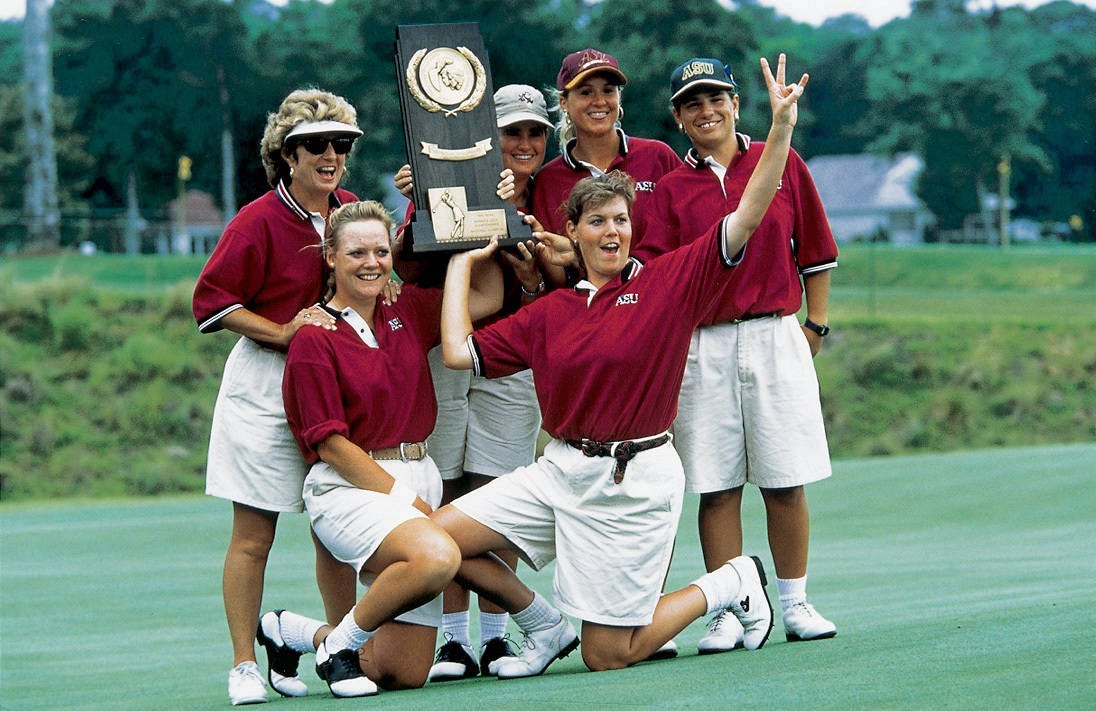
AWARDS
Unsurprisingly, the Sun Devils also took home many awards after the season. Among them, Wendy Ward repeated as the National Player of the Year, the first player to do that since the National Golf Coaches Association (later Women’s Golf Coaches Association) started presenting the award in 1987. Ward would eventually be inducted into the ASU Athletic Hall of Fame in 2009. Heather Bowie became the first player in ASU history to receive the Edith Munson Award presented to the a player that was both an All-American player and academic scholar. Coach Vollstedt took home nearly every award imaginable for a head coach: conference (Pac-10), Regional, and national coach of the year honors as well as Golfweek’s Coach of the Year award.
CLOSING OUT THE 90s
It’s natural for a team that experienced as much success as the ASU golf program had in the last three years to fall off relatively quickly as players graduate and the program turns over. That’s what seemed to happen as the 1995-96 team followed up a 5th place Regional finish with a 6th place showing in the NCAA championship. The bright spots had been winning a fourth consecutive Pac-10 title and a runner-up individual finish by Kellee Booth, proving that despite the “letdown” - as much as a top 10 finish at NCAAs can be called such - Coach Vollstedt was still coaching one of the top programs.
THE 1997 CHAMPIONSHIP
The 1996-97 team finished no lower than fourth in their 10 tournaments during the season, logging four runner-up finishes including at the Pac-10 championship. The undoubted disappointment at the conference championship streak ending was short lived as ASU returned to the site of their 1993 and 1995 Regional victories, and won again. The NCAA championship was once again hosted by Ohio State at the famed Scarlet Course. There, ASU encountered their regular foes: San Jose State, Arizona, Stanford, and UCLA. In the closing holes, Arizona State managed to pull ahead and eek out a two stroke victory. Coach Vollstedt earned a championship ring for her thumb and yet another Golfweek National Coach of the Year award.
THE 1998 CHAMPIONSHIP
The 1997-98 team returned with renewed hopes and high expectations. Runner-up finishes at both the Pac-10 championship and West Regional to Arizona must have ignited something in Coach Vollstedt’s team because the Sun Devils absolutely scorched the field at the NCAA championship held at the University Ridge GC in Wisconsin. It started with a first round 277 (-11) that bested Tulsa’s 1988 fourth round 286 (-10) as the best team round score to par in NCAA championship history. At the end of four rounds, ASU had put 18 strokes between themselves and Florida (and 19 over Arizona), capturing an incomprehensible sixth NCAA championship in nine tries this decade.
Senior Kellee Booth finished 4th individually, right behind sensational freshman teammate Grace Park who still holds the best 2-round score in relation to par (65-65=130/-14) in NCAA championship history. Booth was the only player still around from the 1995 “Three-Peat” team, making her one of the few players in the history of college golf to be a part of three national championship teams. She was inducted into the ASU Athletic Hall of Fame in 2010.
THE 1999 CHAMPIONSHIP
The 1998-99 team set out to match the incredible accomplishment of the 1994-95 team and repeat the three-peat. Grace Park was only a sophomore but she was the clear leader, now the reigning National Collegiate Player of the Year, US Women’s Amateur champ, Women’s Western Am champ, and Trans National champ. She won three spring events including medalist honors at the Pac-10 championship. ASU finished third in both the conference and Regional championships, but still had high hopes.
The 1999 NCAA championship was hosted by Tulsa at the Tulsa Country Club, and for the first three days you could not have asked for a better championship. That all changed on Saturday when rain, hail, and lightning - dare we say Hurricane weather - caused a significant delay. The Sun Devils had entered the day tied for 2nd and 8 shots behind Duke, while Park held a 1 stroke lead over Duke’s Candy Hannemann. With only 5 holes left to play, ASU had cut the lead to just 2 strokes - Park still clinging to her 1 stroke lead - when play was suspended due to the terrible weather. A little over two hours later it became clear that the weather wouldn’t let up in time for play to resume that day, forcing the NCAA rules committee to call the tournament. Because all teams hadn’t finished their rounds, the fourth round results were nullified. Adding to that, the NCAA committee had recently passed a rule stating that play couldn’t be carried over into Sunday, therefore the tournament was called and the third round results were made the official final results. Despite the individual title, Park and her teammates were understandably devastated when Coach Vollstedt had to deliver the news. The Daily Oklahoman wrote the following:
Vollstedt said she approached the rules committee members during the delay, pleading Arizona State’s case and hoping the committee would relent and let the top teams complete the round on Sunday. “I talked to them many times, Vollstedt said. “I guess that’s just the way it is.”
Grace Park was eventually inducted into the ASU Athletic Hall of Fame in 2011. In 2016, she was one of four Arizona State players named to the Pac-12 Women’s Golf All-Century Team, along with Heather Farr, Danielle Ammaccapane, and Wendy Ward.
COACHES CORNER: LINDA VOLLSTEDT
Linda Vollstedt started out her ASU career playing under team coach Betty Graham from 1964-68. She was a member of that 1965 team which won the AIAW championship in Florida during their first dynasty run, and it’s fitting that she lead the team during its second run.
COACHING CAREER
NOTE: most of this research can be credited to Coach Vollstedt’s incredibly detailed ASU profile.
After earning her undergrad (1969) and master’s (1971) degrees at Arizona State, Linda Vollstedt worked for 10 years as a math teacher at Alhambra High School (Phoenix) where she first took on the mantle of head golf coach. After a decade of dominance there - resulting in two state titles, to runner-up finishes, and four undefeated seasons - Coach Vollstedt was recruited back to her alma mater to start the 1980-81 season. Her first decade at the helm of the Arizona State women’s golf program resulted in 5 conference titles - never finishing lower than 4th - and accumulating six top 10 finishes at the NCAA championships, four of which were within the top 5. As written above, the 1990s was a decade of true dominance for the Sun Devils. After 21 years of making Sparky a respected symbol synonymous with success in college golf, Coach Vollstedt retired following the 2000-01 season.
While we all know that winning isn’t everything when it comes to success in the college golf world, it goes a long way in creating a legacy that endures; and Coach Vollstedt’s teams sure did a lot of winning! Along with the six NCAA team championships, four individual titles, and three Regional titles mentioned above, the Sun Devils also won Missouri Valley Conferences titles in 1981, 1984-85, and Pac-10 titles in 1987, 1988, and 1993-96. Her bio for the announcement of the university’s Coach of the Year award named in her honor also outlines the individual achievements of her players:
From 1980 to 2001, Vollstedt, a five-time Golfweek National Coach of the Year, mentored 41 All-Americans, 12 conference medalists, nine U.S. Curtis Cup Team members, six U.S. Public Links winners, four U.S. Amateur Champions and four NCAA individual champions.

MORE AWARDS AND HONORS
The Women’s Golf Coaches Association (WGCA) national coach of the year in 1989, 1994, and 1995, Coach Vollstedt won numerous other conference, regional, and national coaching awards and honors throughout her tenure beyond even those mentioned already. She was elected to multiple halls of fame including the WGCA Hall of Fame in 1994, International Women’s Sports Foundation Hall of Fame in 2003, and the LPGA Hall of Fame in 2020. Additionally, she was named Pac-12 Women’s Golf Coach of the Century in 2016 and became the first female coach in the Pac-12 Hall of Honor when inducted in 2018.
Linda Vollstedt remains near (if not at) the pinnacle of women’s college golf coaching history, and is an inspiration to college coaches in every sport.
Thanks for reading!
Up Next:
In the next post for this series, we will cover the early 2000s as the Sun Devil dynasty gave way to the Blue Devil dynasty under Coach Dan Brooks.
Fun note: Burton won her first four events of the season then had to withdraw after one round in her fifth event due to kidney stones. The team celebrated their third win and dedicated it to her. She came back the next tournament and again won, giving her “wins in her first five tournaments that she completed” (per the Arizona State website covering this season)

